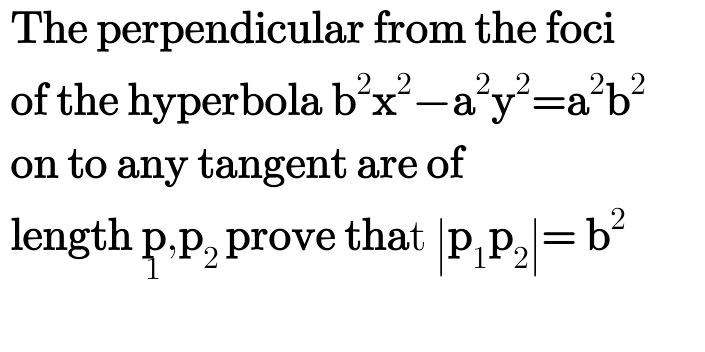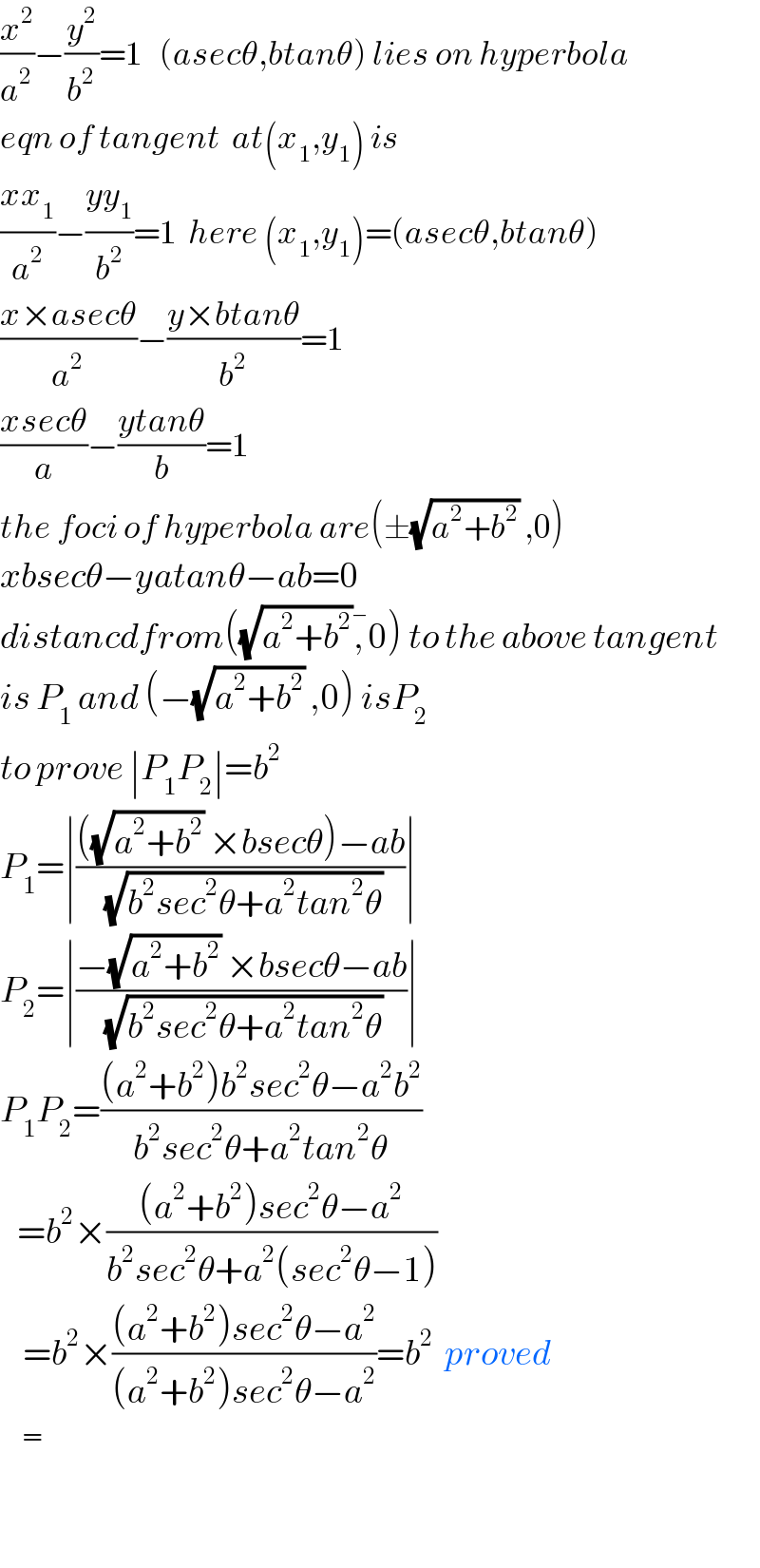Question Number 45638 by peter frank last updated on 14/Oct/18

Answered by tanmay.chaudhury50@gmail.com last updated on 15/Oct/18

$$\frac{{x}^{\mathrm{2}} }{{a}^{\mathrm{2}} }−\frac{{y}^{\mathrm{2}} }{{b}^{\mathrm{2}} }=\mathrm{1}\:\:\:\left({asec}\theta,{btan}\theta\right)\:{lies}\:{on}\:{hyperbola} \\ $$$${eqn}\:{of}\:{tangent}\:\:{at}\left({x}_{\mathrm{1}} ,{y}_{\mathrm{1}} \right)\:{is} \\ $$$$\frac{{xx}_{\mathrm{1}} }{{a}^{\mathrm{2}} }−\frac{{yy}_{\mathrm{1}} }{{b}^{\mathrm{2}} }=\mathrm{1}\:\:{here}\:\left({x}_{\mathrm{1}} ,{y}_{\mathrm{1}} \right)=\left({asec}\theta,{btan}\theta\right) \\ $$$$\frac{{x}×{asec}\theta}{{a}^{\mathrm{2}} }−\frac{{y}×{btan}\theta}{{b}^{\mathrm{2}} }=\mathrm{1} \\ $$$$\frac{{xsec}\theta}{{a}}−\frac{{ytan}\theta}{{b}}=\mathrm{1} \\ $$$${the}\:{foci}\:{of}\:{hyperbola}\:{are}\left(\pm\sqrt{{a}^{\mathrm{2}} +{b}^{\mathrm{2}} }\:,\mathrm{0}\right) \\ $$$${xbsec}\theta−{yatan}\theta−{ab}=\mathrm{0} \\ $$$${distancdfrom}\left(\sqrt{{a}^{\mathrm{2}} +{b}^{\mathrm{2}} }\bar {,}\mathrm{0}\right)\:{to}\:{the}\:{above}\:{tangent} \\ $$$${is}\:{P}_{\mathrm{1}} \:{and}\:\left(−\sqrt{{a}^{\mathrm{2}} +{b}^{\mathrm{2}} }\:,\mathrm{0}\right)\:{isP}_{\mathrm{2}} \\ $$$${to}\:{prove}\:\mid{P}_{\mathrm{1}} {P}_{\mathrm{2}} \mid={b}^{\mathrm{2}} \\ $$$${P}_{\mathrm{1}} =\mid\frac{\left(\sqrt{{a}^{\mathrm{2}} +{b}^{\mathrm{2}} }\:×{bsec}\theta\right)−{ab}}{\:\sqrt{{b}^{\mathrm{2}} {sec}^{\mathrm{2}} \theta+{a}^{\mathrm{2}} {tan}^{\mathrm{2}} \theta}}\mid \\ $$$${P}_{\mathrm{2}} =\mid\frac{−\sqrt{{a}^{\mathrm{2}} +{b}^{\mathrm{2}} }\:×{bsec}\theta−{ab}}{\:\sqrt{{b}^{\mathrm{2}} {sec}^{\mathrm{2}} \theta+{a}^{\mathrm{2}} {tan}^{\mathrm{2}} \theta}}\mid \\ $$$${P}_{\mathrm{1}} {P}_{\mathrm{2}} =\frac{\left({a}^{\mathrm{2}} +{b}^{\mathrm{2}} \right){b}^{\mathrm{2}} {sec}^{\mathrm{2}} \theta−{a}^{\mathrm{2}} {b}^{\mathrm{2}} }{{b}^{\mathrm{2}} {sec}^{\mathrm{2}} \theta+{a}^{\mathrm{2}} {tan}^{\mathrm{2}} \theta} \\ $$$$\:\:\:={b}^{\mathrm{2}} ×\frac{\left({a}^{\mathrm{2}} +{b}^{\mathrm{2}} \right){sec}^{\mathrm{2}} \theta−{a}^{\mathrm{2}} }{{b}^{\mathrm{2}} {sec}^{\mathrm{2}} \theta+{a}^{\mathrm{2}} \left({sec}^{\mathrm{2}} \theta−\mathrm{1}\right)} \\ $$$$\:\:\:\:={b}^{\mathrm{2}} ×\frac{\left({a}^{\mathrm{2}} +{b}^{\mathrm{2}} \right){sec}^{\mathrm{2}} \theta−{a}^{\mathrm{2}} }{\left({a}^{\mathrm{2}} +{b}^{\mathrm{2}} \right){sec}^{\mathrm{2}} \theta−{a}^{\mathrm{2}} }={b}^{\mathrm{2}} \:\:{proved} \\ $$$$\:\:\:\:\overset{=} {\:} \\ $$$$ \\ $$
Commented by peter frank last updated on 20/Oct/18

$$\mathrm{sorry}\:\mathrm{sir}\:\mathrm{i}\:\mathrm{dont}\:\mathrm{it}\:\mathrm{get}\:\mathrm{where}\:\mathrm{this}\:\mathrm{come}\:\mathrm{from}\:\left(\pm\sqrt{\mathrm{a}^{\mathrm{2}} +\mathrm{b}^{\mathrm{2}} },\mathrm{0}\right) \\ $$
